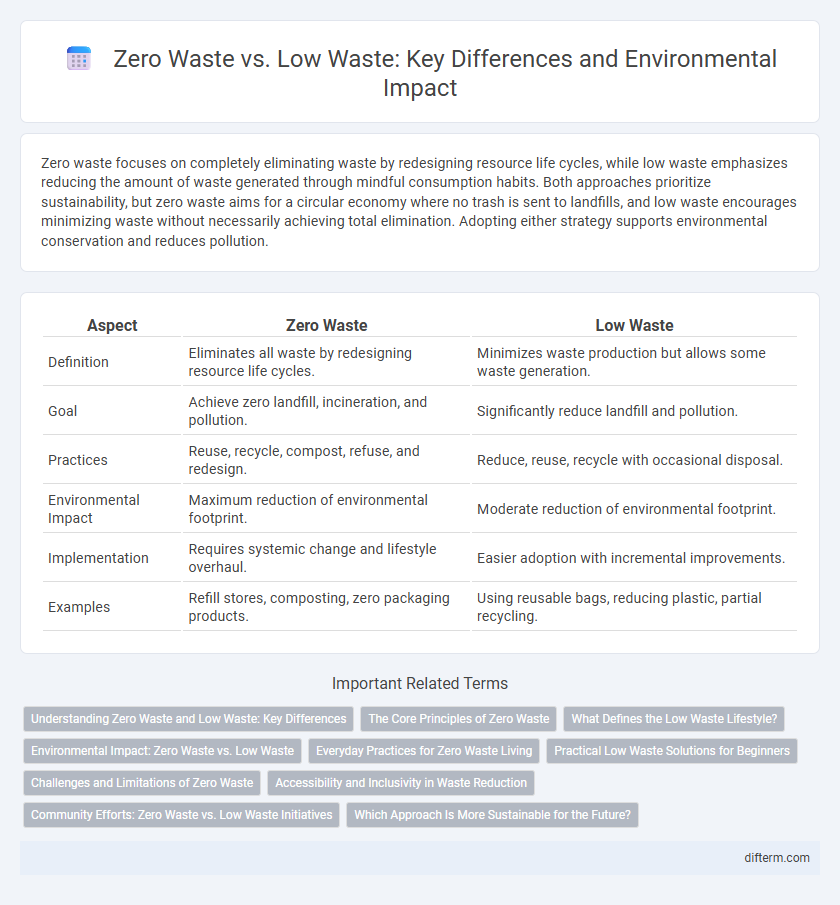Zero waste focuses on completely eliminating waste by redesigning resource life cycles, while low waste emphasizes reducing the amount of waste generated through mindful consumption habits. Both approaches prioritize sustainability, but zero waste aims for a circular economy where no trash is sent to landfills, and low waste encourages minimizing waste without necessarily achieving total elimination. Adopting either strategy supports environmental conservation and reduces pollution.
Table of Comparison
| Aspect | Zero Waste | Low Waste |
|---|---|---|
| Definition | Eliminates all waste by redesigning resource life cycles. | Minimizes waste production but allows some waste generation. |
| Goal | Achieve zero landfill, incineration, and pollution. | Significantly reduce landfill and pollution. |
| Practices | Reuse, recycle, compost, refuse, and redesign. | Reduce, reuse, recycle with occasional disposal. |
| Environmental Impact | Maximum reduction of environmental footprint. | Moderate reduction of environmental footprint. |
| Implementation | Requires systemic change and lifestyle overhaul. | Easier adoption with incremental improvements. |
| Examples | Refill stores, composting, zero packaging products. | Using reusable bags, reducing plastic, partial recycling. |
Understanding Zero Waste and Low Waste: Key Differences
Zero waste aims to eliminate all waste by redesigning resource life cycles, ensuring products are reused, recycled, or composted without landfill or incineration. Low waste focuses on significantly reducing waste generation through mindful consumption, but allows for some waste production due to practical limitations. Understanding these distinctions highlights zero waste as a holistic goal and low waste as a pragmatic approach within sustainable waste management strategies.
The Core Principles of Zero Waste
Zero waste centers on designing products and processes to eliminate waste entirely by prioritizing reuse, recycling, and composting to close the resource loop. Low waste aims to minimize waste generation but may still produce some landfill or incineration-bound materials, lacking the comprehensive circularity of zero waste. Core principles of zero waste emphasize systemic change through sustainable production, responsible consumption, and the recovery of all materials to protect ecosystems and reduce environmental impact.
What Defines the Low Waste Lifestyle?
The low waste lifestyle is defined by significantly reducing waste generation through mindful consumption, prioritizing reusable and recyclable materials, and minimizing single-use products. Unlike zero waste, which aims for absolute elimination of waste, low waste focuses on achievable, gradual improvements to lessen environmental impact. Key practices include composting, supporting sustainable brands, and adopting habits consistent with resource conservation and waste reduction goals.
Environmental Impact: Zero Waste vs. Low Waste
Zero waste eliminates landfill contributions by fully recycling, reusing, or composting materials, drastically reducing pollution and conserving natural resources. Low waste strategies minimize waste production but often still generate some landfill or incinerator-bound materials, leading to a higher environmental footprint than zero waste approaches. Implementing zero waste policies can significantly lower greenhouse gas emissions and toxic waste compared to low waste methods, making it a more sustainable solution for environmental protection.
Everyday Practices for Zero Waste Living
Zero waste living eliminates waste by reusing, recycling, and composting all materials, while low waste reduces but still generates some refuse. Everyday practices include using reusable bags, containers, and water bottles, buying in bulk to avoid packaging, and composting food scraps. Prioritizing minimal consumption and mindful purchasing habits significantly reduces environmental impact and landfill contributions.
Practical Low Waste Solutions for Beginners
Practical low waste solutions for beginners include using reusable bags, containers, and water bottles to minimize single-use plastic consumption. Composting food scraps and choosing bulk or package-free products significantly reduce household waste. Adopting these habits promotes environmental sustainability by lowering landfill contributions while being more accessible than aiming for zero waste immediately.
Challenges and Limitations of Zero Waste
Zero waste faces significant challenges, including widespread consumer habits, limited infrastructure for recycling and composting, and the high initial cost of adopting sustainable practices. It requires systemic changes in manufacturing, packaging, and supply chains that are difficult to scale globally. Unlike low waste approaches, which aim for gradual reduction, zero waste demands near-total elimination of landfill contribution, making it less feasible for many communities.
Accessibility and Inclusivity in Waste Reduction
Zero waste initiatives emphasize complete elimination of waste but often require access to resources and infrastructure that may not be universally available, limiting inclusivity. Low waste approaches prioritize reducing waste to manageable levels, offering more accessible and flexible solutions for diverse communities. Emphasizing low waste strategies can enhance participation across socioeconomic groups by accommodating varying access to recycling, composting, and waste diversion programs.
Community Efforts: Zero Waste vs. Low Waste Initiatives
Zero waste initiatives emphasize eliminating all waste through comprehensive community programs such as widespread composting, strict recycling policies, and bans on single-use plastics, fostering a culture of sustainability and resource circularity. Low waste efforts focus on reducing waste generation by encouraging reusable products, minimal packaging, and selective recycling, making it more accessible for communities transitioning toward environmental responsibility. Both strategies rely heavily on local engagement, education, and support to strengthen participation and achieve measurable reductions in landfill contributions.
Which Approach Is More Sustainable for the Future?
Zero waste aims for complete elimination of waste by redesigning resource life cycles, while low waste focuses on significantly reducing waste through mindful consumption and recycling. Zero waste promotes circular economy principles, enhancing sustainability by minimizing landfill use and resource extraction. Low waste strategies offer more immediate feasibility but may fall short in long-term environmental impact compared to the transformative benefits of adopting zero waste systems.
zero waste vs low waste Infographic

 difterm.com
difterm.com